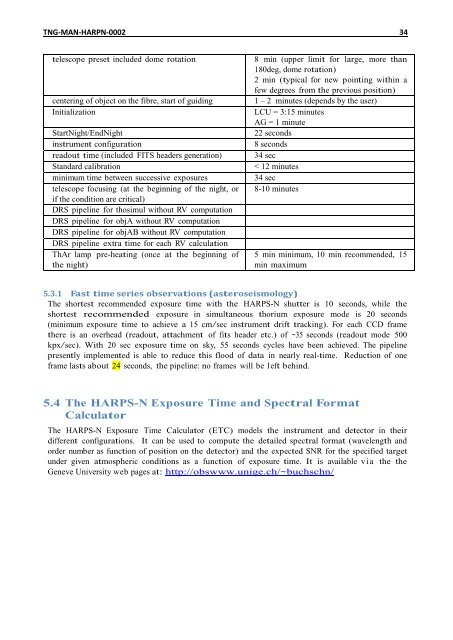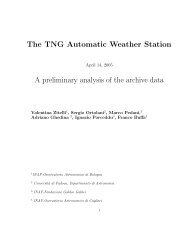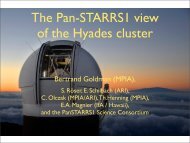HARPS-N USER MANUAL
HARPS-N USER MANUAL - Telescopio Nazionale Galileo
HARPS-N USER MANUAL - Telescopio Nazionale Galileo
- No tags were found...
You also want an ePaper? Increase the reach of your titles
YUMPU automatically turns print PDFs into web optimized ePapers that Google loves.
TNG-MAN-HARPN-0002 34<br />
telescope preset included dome rotation<br />
centering of object on the fibre, start of guiding<br />
Initialization<br />
StartNight/EndNight<br />
instrument configuration<br />
readout time (included FITS headers generation)<br />
Standard calibration<br />
minimum time between successive exposures<br />
telescope focusing (at the beginning of the night, or<br />
if the condition are critical)<br />
DRS pipeline for thosimul without RV computation<br />
DRS pipeline for objA without RV computation<br />
DRS pipeline for objAB without RV computation<br />
DRS pipeline extra time for each RV calculation<br />
ThAr lamp pre-heating (once at the beginning of<br />
the night)<br />
8 min (upper limit for large, more than<br />
180deg, dome rotation)<br />
2 min (typical for new pointing within a<br />
few degrees from the previous position)<br />
1 – 2 minutes (depends by the user)<br />
LCU = 3:15 minutes<br />
AG = 1 minute<br />
22 seconds<br />
8 seconds<br />
34 sec<br />
< 12 minutes<br />
34 sec<br />
8-10 minutes<br />
5 min minimum, 10 min recommended, 15<br />
min maximum<br />
5.3.1 Fast time series observations (asteroseismology)<br />
The shortest recommended exposure time with the <strong>HARPS</strong>-N shutter is 10 seconds, while the<br />
shortest recommended exposure in simultaneous thorium exposure mode is 20 seconds<br />
(minimum exposure time to achieve a 15 cm/sec instrument drift tracking). For each CCD frame<br />
there is an overhead (readout, attachment of fits header etc.) of ~35 seconds (readout mode 500<br />
kpx/sec). With 20 sec exposure time on sky, 55 seconds cycles have been achieved. The pipeline<br />
presently implemented is able to reduce this flood of data in nearly real-time. Reduction of one<br />
frame lasts about 24 seconds, the pipeline: no frames will be left behind.<br />
5.4 The <strong>HARPS</strong>-N Exposure Time and Spectral Format<br />
Calculator<br />
The <strong>HARPS</strong>-N Exposure Time Calculator (ETC) models the instrument and detector in their<br />
different configurations. It can be used to compute the detailed spectral format (wavelength and<br />
order number as function of position on the detector) and the expected SNR for the specified target<br />
under given atmospheric conditions as a function of exposure time. It is available vi a the the<br />
Geneve University web pages at: http://obswww.unige.ch/~buchschn/




